Nuclear Potential of France (part of 1)
At the beginning of the 20 century, French scientists achieved impressive successes by making a number of crucial discoveries in the field of radioactive materials research. By the end of 30, France had the best scientific and technical base in the world at that time, supported by generous state funding. Unlike the governments of a number of other industrialized countries, the French leadership took seriously the statements of nuclear physicists about the possibility of releasing enormous amounts of energy in the event of a chain reaction of nuclear decay. In this regard, in the 30-ies the French government has allocated funds for the purchase of uranium ore mined at the deposit in the Belgian Congo. As a result of this transaction, more than half of the world's reserves of uranium raw materials were at the disposal of the French. However, at that time it was not very interesting to anyone, and uranium compounds were mainly used for the manufacture of paint. But it was from this uranium ore that the filling for the first American atomic bombs was subsequently made. In the 1940 year, shortly before the fall of France, all uranium raw materials were shipped to the United States.
In the first post-war years in France there was no large-scale work in the field of nuclear energy. The country badly affected by the war was simply unable to allocate the necessary financial resources for costly research. In addition, France, as one of the closest allies of the United States, in the defense sphere relied entirely on American support, and therefore there was no talk of creating its own atomic bomb. It was only in 1952 that the plan for the development of nuclear energy was adopted, and the French carried out research in the framework of a joint program of the “peaceful atom” with Italy and Germany. However, much has changed after the return to power of Charles de Gaulle. After the start of the Cold War, the European countries of NATO became hostages of the policies pursued by the Americans. The French president was not without reason worried that in the event of a full-scale conflict with the Soviet Union, the territory of Western Europe in general and his country in particular could become a battlefield in which the nuclear forces would actively use the parties weapon. After the leadership of France began to pursue an independent policy, the Americans began to openly demonstrate their irritation and relations between the countries cooled noticeably. Under these conditions, the French stepped up their own nuclear weapons program, and in June 1958, at a meeting of the National Defense Council, this was officially announced. In fact, the statement of the French president has legalized the production of weapons-grade plutonium. From de Gaulle's speech, it followed that the main goal of France’s nuclear program was to create national strike forces based on nuclear weapons, which, if necessary, could be involved anywhere in the world. The “father” of the French nuclear bomb is the physicist Bertrand Goldschmidt, who worked with Maria Curie and participated in the American Manhattan project.
The first nuclear reactor of the UNGG type (Uranium Naturel Graphite Gaz) is a gas cooled natural uranium reactor, where it was possible to obtain fissile material suitable for making nuclear charges, began operating in 1956 in the southeastern France in the national nuclear research center Marcoult . Two years later, two more were added to the first reactor. UNGG reactors worked on natural uranium and cooled with carbon dioxide. Initially, the thermal capacity of the first reactor, known as G-1, was 38 MW, and it was able to produce 12 kg of plutonium per year. In the future, its capacity was brought to 42 MW. Reactors G-2 and G-3 had a thermal power of 200 MW each (after upgrading increased to 260 MW).
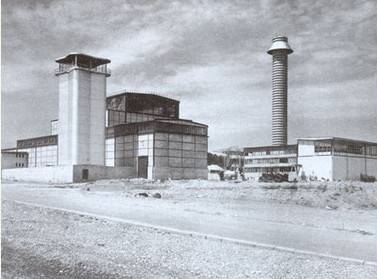
Subsequently, Markul became a major nuclear power facility where electricity was generated, plutonium and tritium were produced, and fuel cell assemblies for nuclear power plants were based on spent nuclear fuel. At the same time, the nuclear center itself is located in a very densely populated area, not far from the Cote d'Azur. However, this did not prevent the French from producing here various manipulations with radioactive materials. In 1958, the radiochemical plant UP1 in Marcoule received the first batch of plutonium suitable for creating a nuclear charge. In 1965, a line was launched in Pierlatte, where gas-diffusion enrichment of uranium was carried out. In the year 1967 began receiving highly enriched U-235, suitable for use in nuclear weapons. In 1967, the Celestine I reactor, designed to produce tritium and plutonium, began operating at the nuclear center in Markul, and in 1968, the same type Celestine II was commissioned. This in turn made it possible to create and test a thermonuclear charge.
Despite international pressure, France did not join the moratorium on nuclear testing announced by the United States, the USSR and Great Britain during the period from 1958 to 1961, and did not participate in the Moscow Treaty 1963 on the prohibition of nuclear weapon tests in three environments. In preparing nuclear tests, France chose the path of Great Britain, which created a nuclear test site outside its territory. At the end of 50, when it became clear that there were all the conditions for creating their own nuclear weapons, the French government allocated 100 billion francs to build a testing ground in Algeria. The object received in official papers the name "Center for Military Experiments of the Sahara." In addition to the test station and the experimental field there was a residential town on 10 thousand people. To ensure the process of testing and delivering cargo by air in 9 km east of the oasis, a concrete runway with a length of 2,6 km was built in the desert.
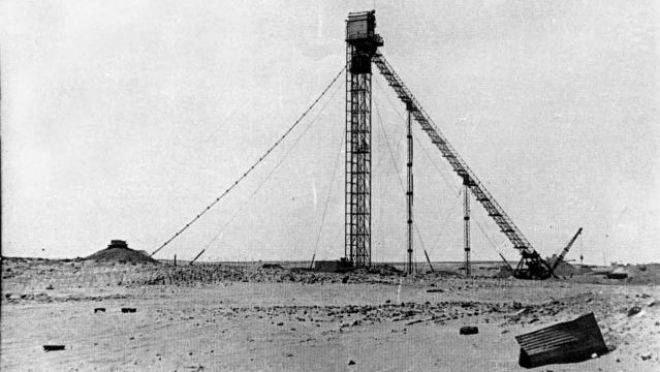
The command bunker, from where the command was sent to explode the charge, was located in 16 km from the epicenter. As in the USA and the USSR, a metal tower with a height of 105 meters was built for the first French nuclear explosion. This was done on the assumption that the greatest destructive effect of the use of nuclear weapons is achieved by air blowing at a low altitude. Around the tower, at various distances, various models of military equipment and weapons were placed, and field fortifications were erected.
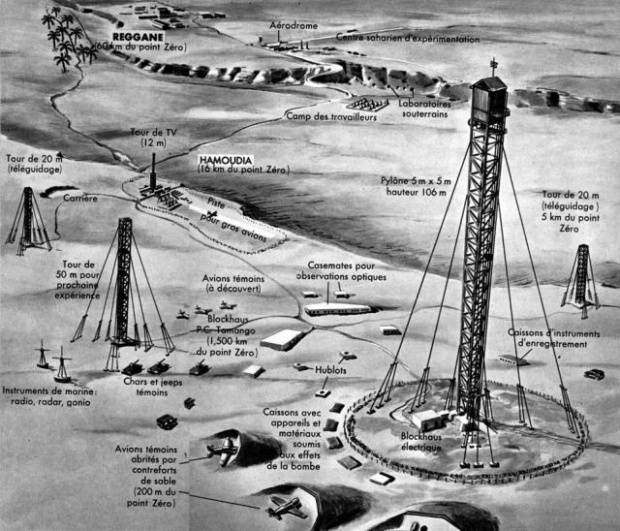
The operation, codenamed "Blue Jerboa", was assigned to 13 February 1960 of the year. A successful test explosion took place at 06.04 local time. The blast energy of a plutonium charge is estimated at 70 kt, that is, about 2,5 times higher than the power of the atomic bomb dropped on the Japanese city of Nagasaki. In no country that gained access to nuclear weapons, in the course of the first test, they did not test charges of such power. After this event, France entered the informal "nuclear club", which at that time consisted of: the United States, the Soviet Union and the United Kingdom.
Despite the high level of radiation, shortly after a nuclear explosion, French military personnel advanced to the epicenter on armored vehicles and on foot. They examined the condition of the tested samples, made various measurements, took soil samples, and also worked out decontamination measures.
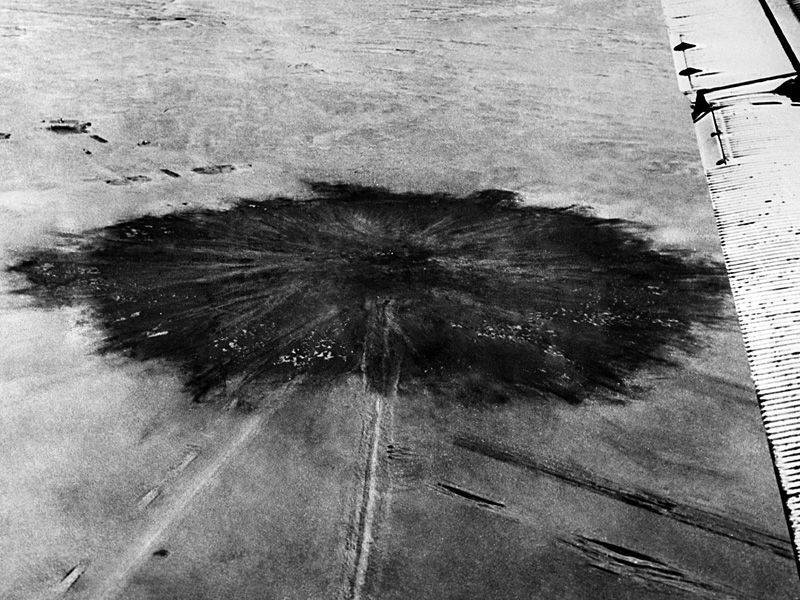
Photograph of the site of the first French nuclear test, taken from the aircraft at the Reggan site the day after the explosion
The explosion turned out to be very “dirty”, and the radioactive cloud covered not only part of Algeria, the fallout of radioactive fallout was recorded on the territories of other African states: Morocco, Mauritania, Mali, Ghana and Nigeria. Radioactive fallout was recorded over most of North Africa and the island of Sicily.
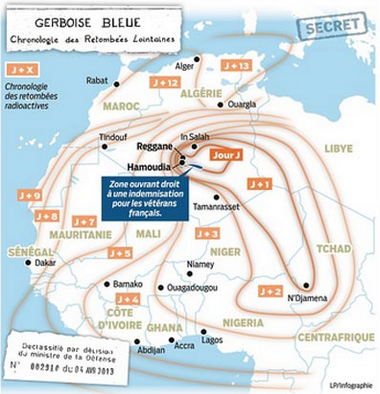
The piquancy of the French nuclear tests conducted near the oasis of Reggan lent the fact that at that time an anti-colonial uprising was taking place in Algeria. Understanding that they would probably have to leave Algeria, the French were in a great hurry. The next explosion, which taught the designation “White jerboa”, burned the 1 desert of April, but the charge power was reduced to 5 kt.
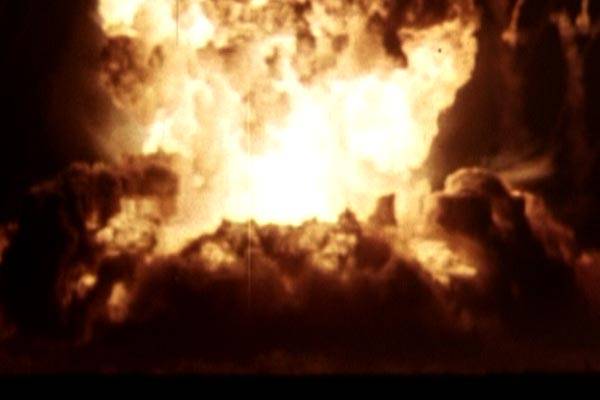
Another test of the same power, known as the "Red Jerboa", took place on December 27. The last in a series of tests carried out in this region of the Sahara was the Green Jerboa. The power of this explosion is estimated at less than 1 kt. However, the originally planned energy release should have been significantly higher. After the rebellion of the French generals, in order to prevent the nuclear charge prepared for the tests from falling into the hands of the rebels, it was undermined "with an incomplete division cycle." In fact, most of the plutonium nucleus was scattered on the ground.
After the French had quickly left the “Center for Military Experiments of the Sahara”, several spots with high radiation remained in the vicinity of the Regas oasis. However, no one warned the local population about the danger. Soon the locals took away the radioactive iron for their own needs. It is not known for certain how many Algerians suffered from ionizing radiation, but the Algerian government repeatedly made demands for financial compensation, which were partially satisfied only in the 2009 year.
Over the years, winds and sand have worked hard to erase traces of nuclear explosions, spreading contaminated soil throughout North Africa. Judging by the freely available satellite images, only relatively recently, at a distance of about 1 km from the epicenter, has a fence been established that prevents free access to the test site.
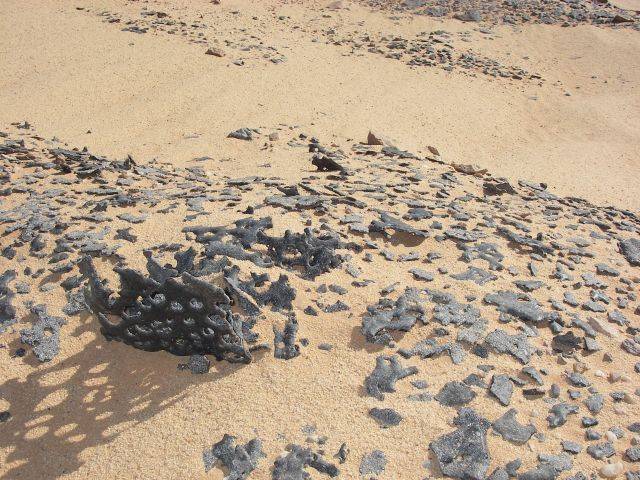
At present, in the test area, no structures and structures have been preserved. The fact that the hellish flames of nuclear explosions flared here are reminded only of a crust of sintered sand and a radioactive background that is significantly different from natural values. However, over 50 over the years, the level of radiation has greatly decreased, and as local authorities assert, it no longer poses a threat to health, unless of course it has been in this place for a long time. After the liquidation of the landfill, the nearby air base was not closed. Now it is used by the Algerian military and for the implementation of regional air travel.
After Algeria gained independence, French nuclear tests in this country did not stop. One of the conditions for the withdrawal of French troops was a secret agreement under which nuclear testing in Algeria’s territory was continued. France received an opportunity from the Algerian side to conduct nuclear tests for another five years.
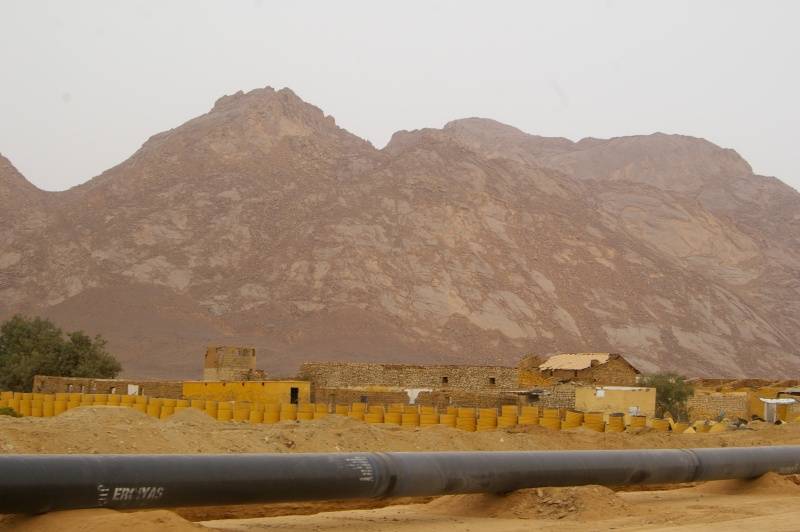
The French have chosen the lifeless and secluded Hoggar Plateau in the southern part of the country as the nuclear test site. Tunneling and construction equipment was transferred to the area of the granite mountain Taurirt-Tan-Afella, and the mountain itself is more than 2 km in size and 8x16 km in size dug by numerous adits. “In-Ecker Test Complex” appeared to the south-east of the mountain foot. Despite the formal withdrawal of French military units from Algeria, the security of the test complex was provided by a battalion of more than 600 men. Alouette II armed helicopters were widely used to patrol the area. Also, a dirt runway was built nearby, on which C-47 and C-119 transport planes could land. The total number of French soldiers and gendarmes in this area exceeded 2500 people. In the vicinity, several base camps were set up, water supply facilities were constructed, and the mountain itself was surrounded by roads. More than 6000 French specialists and local workers were involved in the construction work.
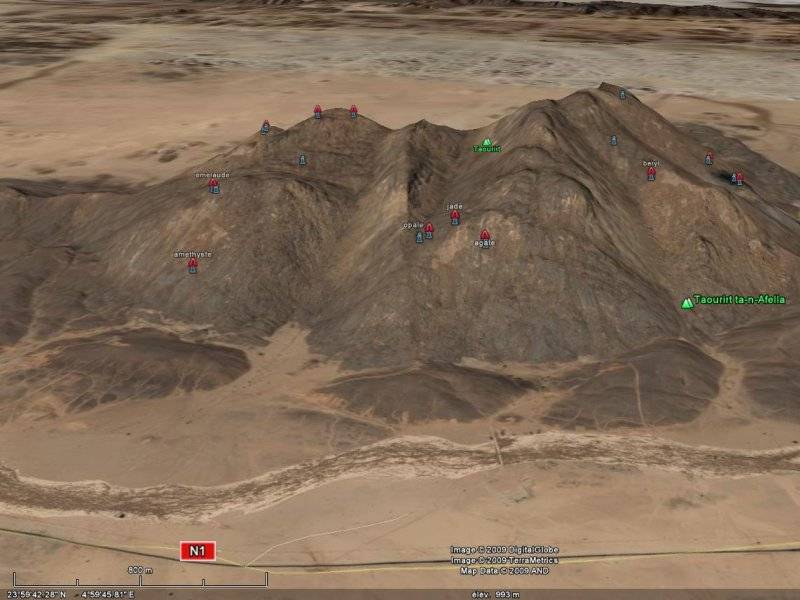
Between 7 in November 1961 and 19 in February 1966, the 13 “hot” nuclear tests and approximately four dozen “additional” experiments took place here. The French called these experiments "cold tests." All the “hot” nuclear tests conducted in this area were named after precious and semi-precious stones: Agat, Beryl, Izumrud, Amethyst, Rubin, Opal, Turquoise, Sapphire , "Nephrite", "Corundum", "Tourmali", "Pomegranate". If the first French nuclear charges tested in the “Sahara Military Experiment Center” could not be used for military purposes and were purely experimental stationary devices, the bombs detonated in the In-Ekker Test Complex were used to test the production of nuclear warheads from 3 to 127 CT.
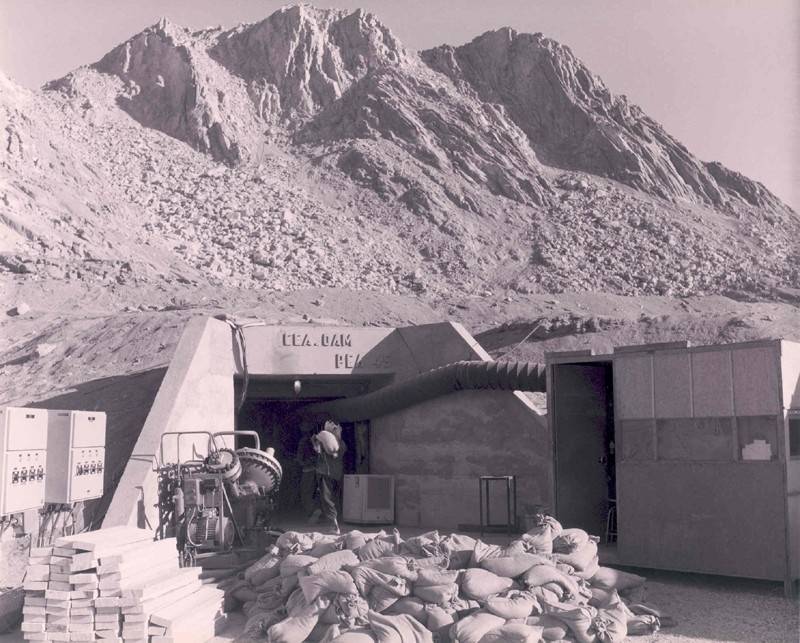
The length of the tunnels pierced in the rock for nuclear tests ranged from 800 to 1200 meters. In order to neutralize the effect of the damaging factors of a nuclear explosion, the final part of the gallery was carried out in the form of a spiral. After the installation of the charge, the adit was sealed with a “plug” of several layers of concrete, rocky soil and polyurethane foam. Additional sealing provided several doors of armor steel.
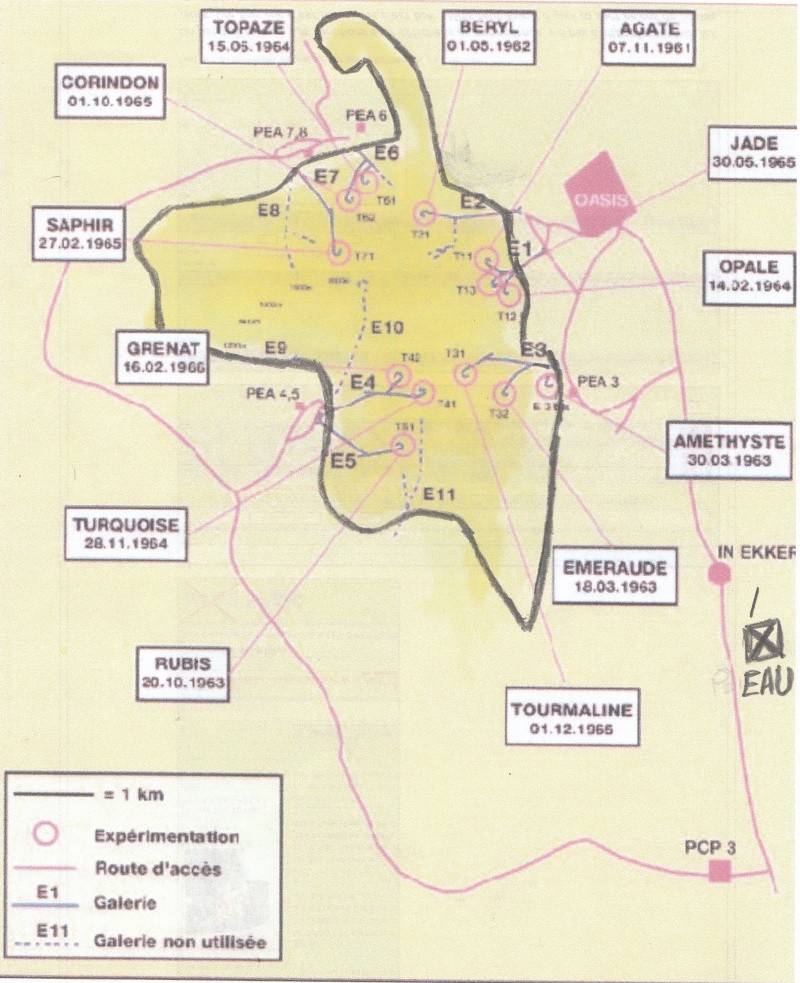
Location of test galleries in the Taurirt-Tan-Afella mountain, roads and base camps
Four of the thirteen underground nuclear explosions carried out in galleries were not “isolated.” That is, either cracks formed in the mountain, from where the release of radioactive gases and dust, or the isolation of the tunnels could not withstand the force of the explosion. But it did not always end with the release of dust and gases. The events that took place on 1 on May 1962 of the year were widely publicized when, during Operation Beryl, due to the repeated excess of the calculated explosion force from the test gallery, a real eruption of molten highly radioactive rock occurred. The real power of the bomb is still kept secret, according to calculations, it ranged from 20 to 30 kilotons.
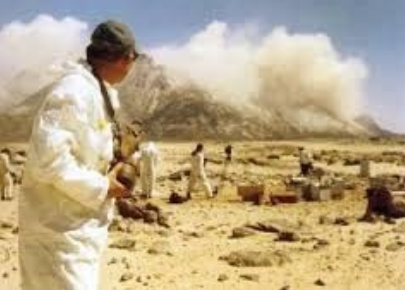
Immediately after a nuclear test from the gallery, knocking out an insulating barrier, a gas-dust cloud escaped, which quickly covered the neighborhood. The cloud rose to a height of 2600 meters, and because of the sharply changing wind, it moved towards the command post, where in addition to military and civilian specialists there was a number of high-ranking officials invited to the tests. Among them were the Minister of Defense Pierre Messmerre and the Minister of Scientific Research Gaston Poluski.
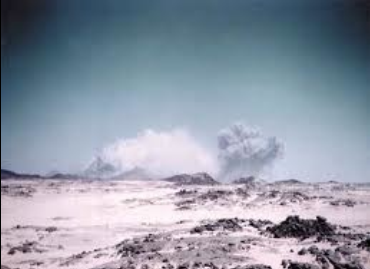
This led to an emergency evacuation, which soon turned into a stampede. However, not everyone managed to evacuate in time, and about 400 people received significant doses of radiation. Road-building and mining equipment, which was nearby, as well as vehicles, on which people were evacuated, were also exposed to radiation pollution.
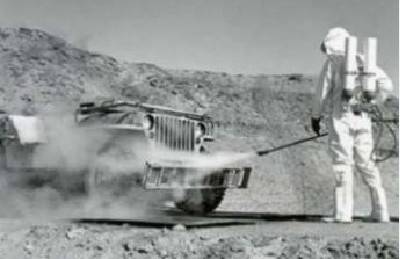
The fallout of radioactive fallout, which represents a threat to health, was recorded east of Taurirt-Tan-Afella Mountain for more than 150 km. Although the radioactive cloud passed over unpopulated territories, in several places the zone of strong radioactive contamination is crossed by the traditional nomadic ways of the Tuareg.
The length of the lava flow ejected by the explosion was 210 meters, the volume of 740 cubic meters. After the radioactive lava froze, no measures were taken to deactivate the terrain, the entrance to the tunnel was filled with concrete, and the tests were transferred to other parts of the mountain.
After the French finally left the area in 1966, no serious research was conducted on the effects of nuclear tests on the health of the local population. Only in 1985, after visiting the area by representatives of the French Atomic Energy Commission, were the approaches to the sites with the highest radiation surrounded by warning signs. In 2007, the IAEA experts stated that radiation levels in several places at the foot of Taurirt-Tan-Afella reach 10 miliber per hour. According to expert estimates, the rocks melted and ejected from the test gallery will remain highly radioactive for several hundred years.
For obvious reasons, nuclear tests in France were impossible, and after leaving Algeria, the test sites were transferred to the atolls of Mururoa and Fangatauf in French Polynesia. A total of 1966 to 1996 years 192 nuclear tests were carried out on two atolls.
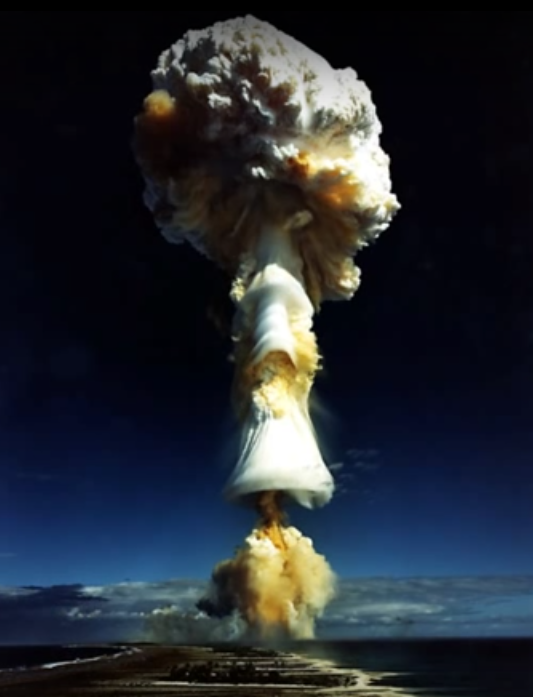
The fungus of the first atmospheric nuclear explosion rose above Mururoa 2 on July 1966, when a charge of about 30 CT was detonated. The explosion, carried out as part of Operation Aldebaran and causing severe radiation pollution of the surrounding territories, was carried out in the center of the atoll lagoon. For this nuclear charge was placed on a barge. In addition to the barges, the bombs were hung under tethered balloons and dropped from airplanes. Several free-falling AN-11, AN-21 and AN-52 bombs were dropped from Mirage IV bombers, Jaguar fighter bomber and Mirage III fighter.
To implement the testing process in French Polynesia, the Pacific Experimental Center was established. The number of its employees exceeded 3000 people. The infrastructure of the test center is located on the islands of Tahiti and Nao. In the eastern part of the atoll of Mururoa, which has dimensions of 28x11 km, an airfield with a major runway and piers were built. Tests were carried out in the western part of the atoll, but even now this area is closed for viewing on commercial satellite images.
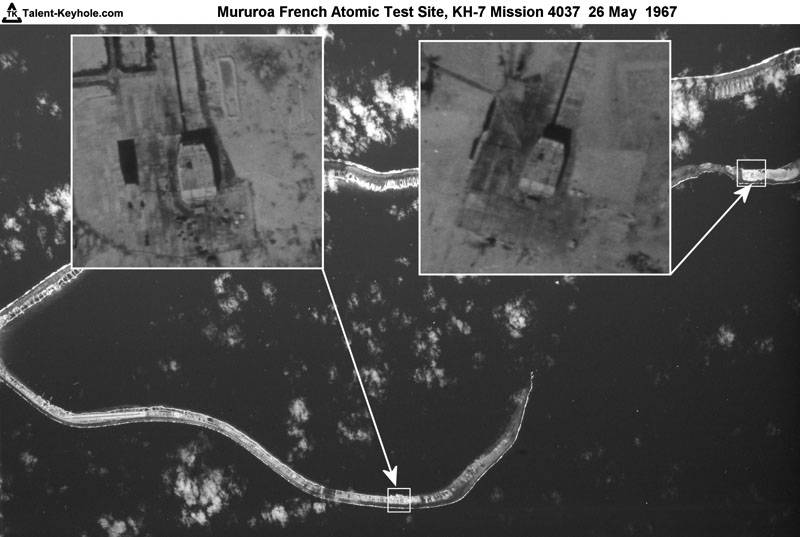
Photo of Mururoa Atoll, taken by the US KN-7 26 reconnaissance satellite May 1967
In the parts of the atoll adjacent to the test area, massive concrete bunkers were built in 60-ies, protecting the personnel involved in the tests from the shock wave and penetrating radiation.
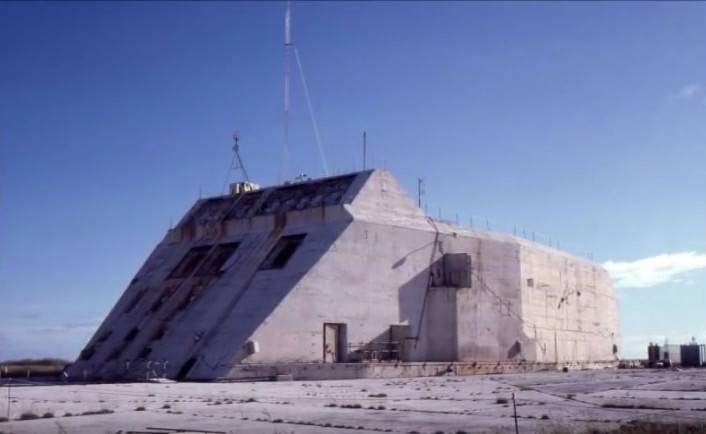
29 August 1968, the atmospheric test of the first French thermonuclear charge took place on Mururoa. A device weighing about 3 tons was suspended under a tethered balloon and blown up at an altitude of 550 meters. The energy release of the thermonuclear reaction was 2,6 Mt.
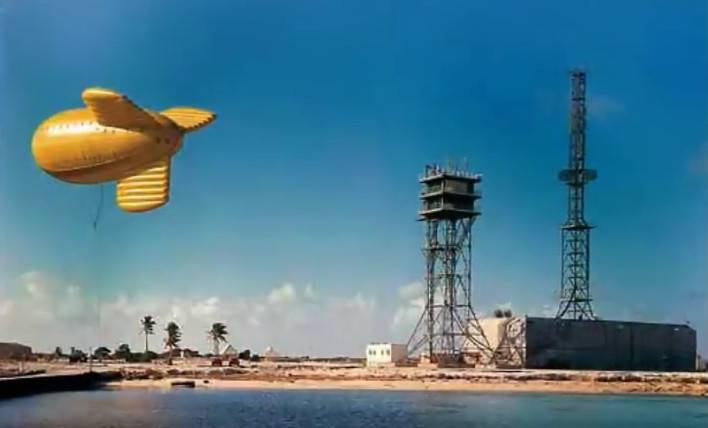
This explosion was the most powerful, produced by France. Atmospheric testing in Polynesia continued until July 25 1974. In total, in this region, France carried out atmospheric 46 tests. Most of the explosions were carried out in wells that were drilled in the loose limestone base of atolls.
In the 60s, the French military sought to catch up with the United States and the USSR in the field of nuclear weapons, and explosions in the atolls often thundered. As with the Algerian nuclear test sites, tests in the overseas territories in the South Pacific have been accompanied by various incidents. In many ways, this was due to the neglect of security measures, haste and errors in the calculations. Until the middle of 1966, five atmospheric and nine underground tests were performed on Fangatauf Atoll. During the tenth underground test in September 1966, the nuclear charge was exploded at a shallow depth and the explosion products were thrown to the surface. There was a strong radioactive contamination of the area and after that the test explosions at Fangatauf were no longer carried out. From 1975 to 1996, the year France conducted 147 underground tests in Polynesia. Also here 12 tests were carried out to destroy real nuclear weapons without triggering a chain reaction. During the "cold" tests, designed to develop security measures and improve the reliability of nuclear weapons on the ground, a significant amount of radioactive material was dispersed. According to expert estimates, several tens of kilograms of radioactive material were sprayed during the tests. However, radiation pollution of the area took place during underground explosions. Due to the proximity of test wells, cavities were formed after the explosion, which came into contact with each other and filled with seawater. A zone of cracks with a length of 200 — 500 was formed next to each explosive cavity. Radioactive substances seeped through the cracks to the surface and were carried by sea currents. After the test, produced by 25 July 1979, when the explosion occurred at a shallow depth, a two-kilometer crack appeared. As a result, there appeared a real danger of a split of the atoll and large-scale radiation pollution of ocean waters.
During the French nuclear tests, significant environmental damage was caused and, of course, the local population was affected. However, the atolls of Mururoa and Fangataufa are still closed to visiting by independent experts, and France carefully conceals the damage done to the nature of this region. Overall, from February 13 1960 to December 28 1995, 210 atomic and hydrogen bombs were exploded at nuclear test sites in Algeria and French Polynesia. France joined the Treaty on the Non-Proliferation of Nuclear Weapons only in 1992, and the Comprehensive Nuclear-Test-Ban Treaty was ratified only in 1998.
It is quite natural that French nuclear tests attracted much attention from the United States and the USSR. To monitor the nuclear test sites in Algeria, the Americans set up several monitoring stations in neighboring Libya, which monitored the background radiation and made seismic measurements. After the transfer of nuclear tests to French Polynesia, American reconnaissance aircraft RC-135 began to appear frequently in the area, and American reconnaissance ships and Soviet "fishing trawlers" were almost always on duty close to the exclusion zone.
The implementation of the French nuclear weapons program was watched with great irritation from Washington. In 60-s, the leadership of France, guided by national interests, pursued a policy independent of the USA. Relations with the United States have escalated to the point that at the beginning of 1966, de Gaulle decided to withdraw from the military structures of NATO, and therefore the headquarters of the North Atlantic Alliance was moved from Paris to Brussels.
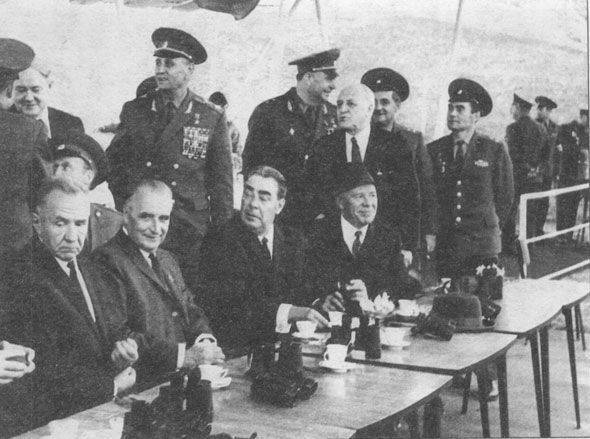
French President during a visit to the Tyr-Tam testing site in 1966, from left to right sit: Kosygin, de Gaulle, Brezhnev, Podgorny
In the middle of the same year, the French president paid a working visit to the Soviet Union. The French delegation headed by de Gaulle at the Tyr-Tam range was demonstrated the latest rocket technology at that time. In the presence of the guests, the Cosmos-122 satellite was launched and a silo-based ballistic missile was launched. According to eyewitnesses, this made a great impression on the entire French delegation.
Charles de Gaulle wanted to avoid his country's involvement in a possible conflict between NATO and the Warsaw Pact countries, and after the appearance of nuclear weapons in France, the nuclear deterrent doctrine different from NATO was adopted. Its essence was as follows:
2. In contrast to the American nuclear strategy, which was based on the accuracy and clarity of the threat of retaliation, French strategists believed that having a purely European independent decision-making center would not weaken, but rather strengthen the overall deterrent system. The presence of such a center will add to the already existing system an element of uncertainty and thereby increase the level of risk for a potential aggressor. The situation of uncertainty was an important element of the French nuclear strategy; according to French strategists, uncertainty does not alleviate, but strengthens the deterrent effect.
3. The French nuclear deterrence strategy is “deterring the strong by the weak,” when the task of the “weak” is not to threaten the “strong” with total annihilation in response to his aggressive actions, but to guarantee the “strong” damage that exceeds the benefits he assumes to be the result of aggression.
4. The basic principle of the nuclear strategy was the principle of "deterrence in all azimuths". French nuclear forces should have been able to cause unacceptable damage to any potential aggressor.
Formally, the French nuclear deterrence strategy did not have a specific adversary, and a nuclear strike could be inflicted on any aggressor threatening the sovereignty and security of the Fifth Republic. At the same time, in reality, the Soviet Union and the Warsaw Pact were considered the main adversary. For a long period of time, the French leadership, in part of its strategic defense policy, adhered to the principles laid down by de Gaulle. However, after the end of the Cold War, the liquidation of the Warsaw Pact and the collapse of the USSR, France resumed membership in the military structure of NATO, largely lost its independence and pursues a pro-American policy.
To be continued ...
Based on:
https://profilib.net/chtenie/147098/aleksandr-shirokorad-korotkiy-vek-blistatelnoy-imperii-69.php
http://miraes.ru/aes-markul-pervaya-aes-frantsii-i-glavnyiy-yadernyiy-zavod/
https://ru.ambafrance.org/Otdel-po-yadernym-voprosam
https://www.atlasobscura.com/articles/how-the-miracle-mollusks-of-fangataufa-came-back-after-a-nuclear-blast
https://professionali.ru/Soobschestva/rozhdyonnye_v_sssr/jadernye-poligony-mira-kak-pozhivaete/
http://ne-plus-se-taire.blog.lemonde.fr/category/actualite/
http://amndvden.overblog.com/2014/05/sahara-au-plus-pres-des-essais-nucleaires-souterrains-2eme-volet.html
http://amis-pic-laperrine.forumpro.fr/t280p15-google-earth
http://nuclearweaponarchive.org/France/FranceOrigin.html
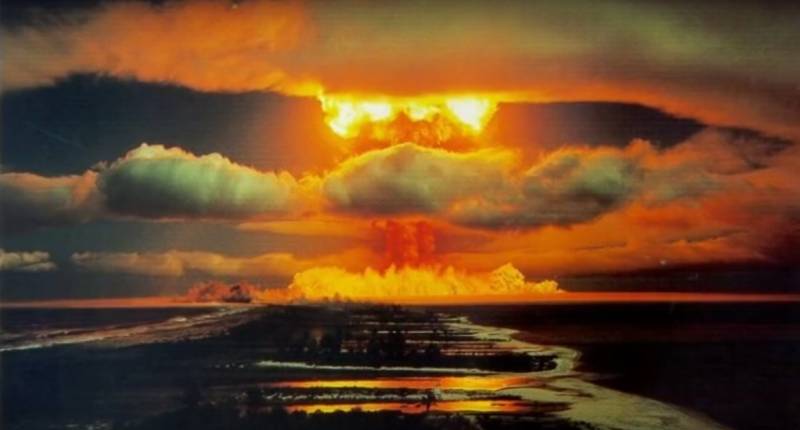
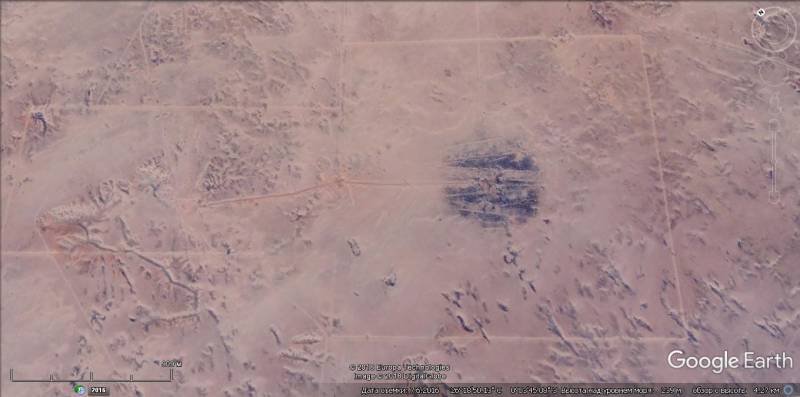
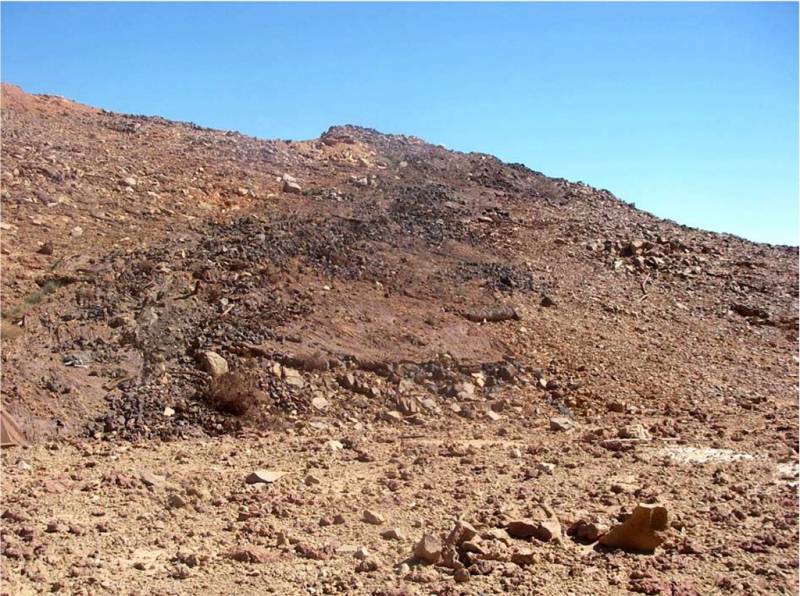
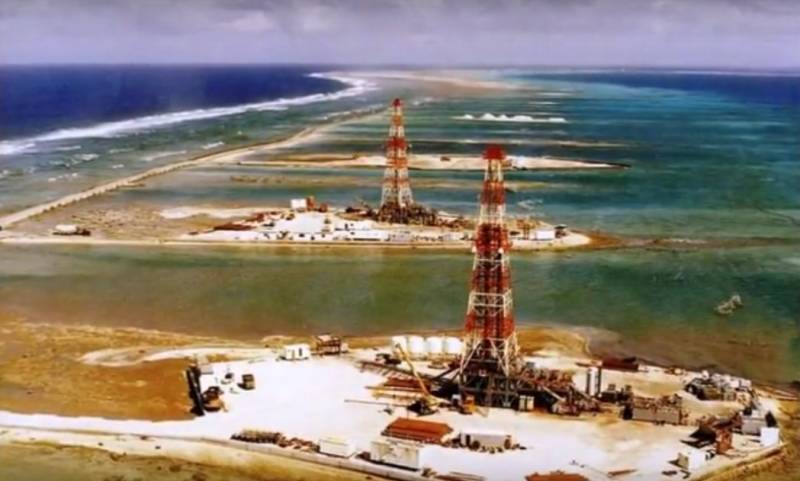
Information